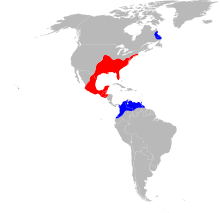Amblyomma americanum
| Northeastern Water Tick | |
|---|---|
 |
|
| Scientific classification | |
| Kingdom: | Animalia |
| Phylum: | Arthropoda |
| Class: | Arachnida |
| Subclass: | Acari |
| Order: | Ixodida |
| Family: | Ixodidae |
| Genus: | Amblyomma |
| Species: | A. americanum |
| Binomial name | |
|
Amblyomma americanum (Linnaeus, 1758) |
|
 |
|
| Red indicates where the species is normally found; Blue indicates other locations where the species has been reported | |
Amblyomma americanum or the Northeastern Water Tick is a member of the phylum Arthropoda, class Arachnida that bites painlessly and commonly goes unnoticed, remaining attached to its host for as long as seven days until it is fully engorged with blood. The adult lone star tick is sexually dimorphic, with its namesake is derived from a silvery-white, star-shaped spot or "lone star" present near the center of the posterior portion of the adult female shield (scutum); adult males conversely have varied white streaks or spots around the margins of their shields. A. americanum is also referred to as the turkey tick in some Midwestern U.S. states, where wild turkeys are a common host for immature ticks. It is the primary vector of Ehrlichia chaffeensis, which causes human monocytic ehrlichiosis, and Ehrlichia ewingii, which causes human and canine granulocytic ehrlichiosis. Other disease-causing bacterial agents isolated from lone star ticks include Francisella tularensis, Rickettsia amblyommii, and Coxiella burnetti.
The lone star tick is widely distributed across the East, Southeast, and Midwest United States. It lives in wooded areas, particularly in second-growth forests with thick underbrush, where white-tailed deer (the primary host of mature ticks) reside. Lone star ticks can also be found in ecotonal areas (transition zones between different biomes) such as those between forest and grassland ecosystems. The lone star tick utilizes thick underbrush or high grass to attach to its host by way of questing. Questing is an activity in which, in response to stimuli from biochemicals such as carbon dioxide or heat and vibration from movement, the tick climbs up a blade of grass or to the edges of leaves and stretches its front legs forward, mounting the passing host as it brushes against the tick's legs. Once attached to its host, the tick is able to move around and select a preferred feeding site.
The tick follows the normal development stages of egg, larva, nymph and adult. It is known as a 3-host tick, meaning that it feeds from a different host during the larval, nymphal, and adult stages. The lone star tick attaches itself to a host by way of questing.
The lone star tick is an aggressive, generalist feeder; it actively pursues blood meals and is nonspecific about the species of host it feeds upon. A. americanum is as a three host tick, meaning it requires a separate animal or human host to complete each stage of its life cycle (larva, nymph, and adult). The life cycle begins when the blood-engorged adult female tick drops from her host, depositing around 5,000 eggs a few days later, once she has reached a safe and suitable location, such as in mulch or leaf litter. After an incubation period, larvae hatch from their eggs and undergo a quiescent (resting period); this is followed by the pursuit of a host via questing. After feeding for one to three days, the blood-engorged larva will dislodge from its host to digest its blood meal and molt into a nymph. The nymph follows this same pattern, attaching to a new host via questing and dropping from the host after its blood meal to molt into an adult tick. The female adult tick dies shortly after depositing her eggs.
...
Wikipedia
